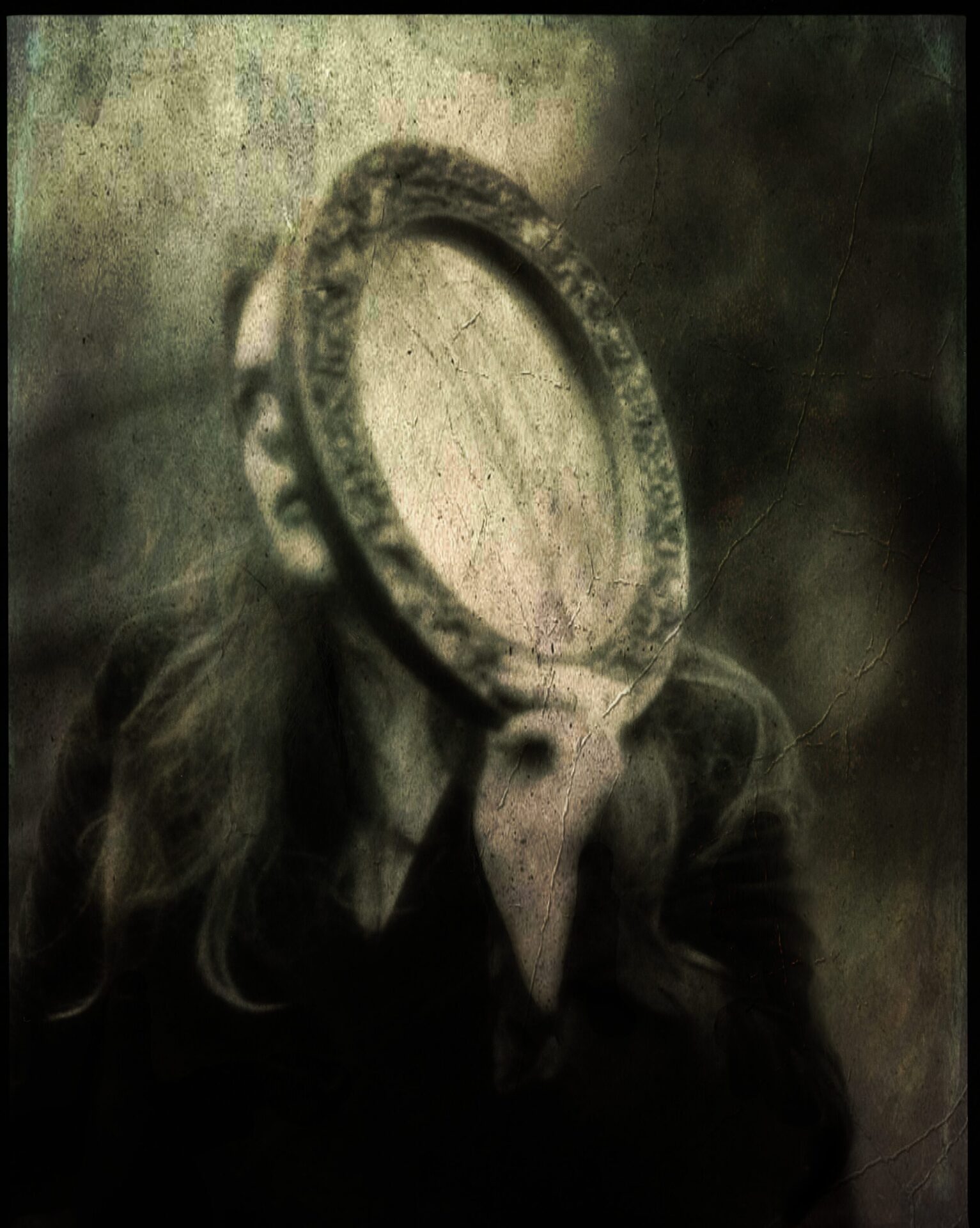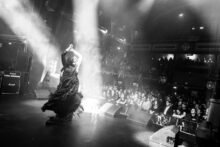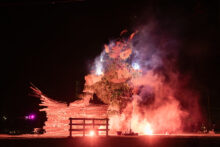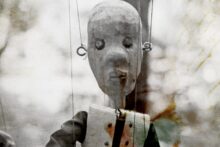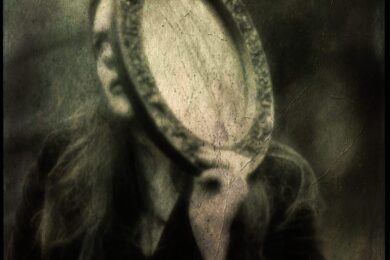Kristján Norge’s problems began the day he stared into his steel shaving mirror and saw a demon looking back at him. Born on Shetland in 1930, Norge left to pursue something of an itinerant life, washing up in Edinburgh to become a writer. He was only 19 when he composed the dizzying modernist work of poetry Optik: A History Of Ghost in 1950, influenced by correspondence on natural magic from the “father of modern experimental optics” and inventor of the kaleidoscope, Sir David Brewster, to the novelist, Sir Walter Scott. Specifically, Norge became obsessed with two letters concerning the summoning of a troubling figure called ‘John Christ’, a visionary homunculus who could be created by phantasmagorical alchemy.
How far Norge pursued these rites is unclear but this research and an unusual attempt to map the history of human anatomy onto Edinburgh’s subterranean necropolis, the Underground City, left him troubled and restless once more. After a failed attempt to find peace of mind via psychotherapy, in 1960 he moved to Eilean a’ Bhàis – the island of the dead – in order to “research memory”. On this rocky outcrop in the Outer Hebrides, he struck up a neighbourly relationship with lighthouse keeper and amateur antiquarian Luce Moncrieff, spending his days tending to donkeys and writing poetry, albeit some in morse code. But any happiness generated by his new life was short lived. Norge, perhaps unbalanced by the harshness and solitude of northerly life and the dawning realisation that his new home had been a place of interment for millennia, became convinced he was actually a demon. His diaries, written in a shaky hand in an old ship’s log book between the new moon of 11 July and the full moon of 22 December 1961 – recently published by Broken Sleep Books under the title of The Demon Tracts – reveal the extent of his “dorchar taibhse”, or dark vision. “I can now ignite my overcoat at will and it flares wildly in varying lunisolar colours”, he writes at one point.
But if he had succumbed to madness, it did not stand in the way of a great outpouring of creative work. As well as his log book, he produced a “star atlas” and a new manuscript, Ravage – essentially a piece of automatic writing dictated to him by one of the Sluagh nam Marbh or “host of the dead” – a Gaelic wind comprised of fallen angels, members of the sìth, and the many dead souls of the island. Whether we can call Norge the author or not, the writing appears to have occurred in a state of dismay at a newfound and hellish state of anamnesis: the sudden and awful awareness of something horrific he had previously been oblivious to. This supernova act of creation represented a last ditch attempt to manifest an “orphic system” of self-imposed amnesia, in order to forget his demonic status and to rid himself of the suspicion that Eilean a’ Bhàis was in fact a “mnemonic portal” or gateway to the infernal underworld; that he was on the threshold of Hell itself. And then he vanished abruptly before the end of 1961.
Lucky for us then that the lighthouse keeper Moncrieff had the presence of mind to undertake the “monumental task” of piecing together Norge’s terrifying and desperate act of occult brinksmanship. She took fragments of poetry, pyrography, star charts, maps, frantic occult graffiti scratched into the lighthouse walls and letters he concealed in significant locations across the island and condensed them into a typewritten document. Lucky that is, because Moncrieff herself disappeared in unusual circumstances not long after completing this task.
All of which is so very compelling and creates such a vibrant tapestry that one is initially unwilling to pull on any of the fine threads hanging from it. But a few gentle tugs reveals that despite the richness of his story, there doesn’t appear to be any mention of Kristján Norge on the internet which is over a year old and while there are two books published that contain his writing – The Demon Tracts and Ravage: An Astonishment Of Fire, with more on the way – the former has an introduction written by the multidisciplinary experimental artist and writer MacGillivray and the latter is edited by her. It is also worth bearing in mind that MacGillivray is the main artist avatar of Kirsten Norrie. And if your eye has snagged on that name for a second then, yes, I also noticed the passing resemblance between Kirsten Norrie and Kristján Norge. And as you pull away at more threads, the tapestry starts to come apart revealing a very different story underneath and that’s where your problems as a reader begin. But then, these are good problems to have.
When asked if she is actually Kristján, the artist Kirsten Norrie says: “My surname has etymological roots in the word ‘Norway’ and my father, a helicopter pilot, was hugely drawn to the country. But also Kristján plays on the notion of Christian the protagonist from John Bunyan’s Pilgrim’s Progress. So yes, I am he, but in some disguise.”
I feel that the words “some disguise” constitute a bit of an understatement. Kirsten Norrie is speaking to me about a dizzyingly wide-ranging project she is undertaking as MacGillivray while drawing heavily on the work of a lighthouse keeper called Moncrieff who was working from a variety of unusual sources left by a mad poet called Norge who in turn claimed he was merely transcribing information imparted to him by angels and fairies as well as the spectral transmissions of human lives stretching all the way from the 19th Century back to when the Hebrides were first settled in the early Neolithic over 10,000 years ago. The creation of such an incredible bricolage that moves dynamically in every conceivable direction – through time; across space; across media; between languages; across metaphysical thresholds; through a kaleidoscopic array of nestled narrators, each story housed inside another, with mirrored traumas stacked one upon another – can be taken as a metaphor for the difficulties created by folklore research.
She says: “Ravage was devised as a literal attempt to find practical and poetical solutions to describe the memory of an event which has been damaged into repetition, flashback and waking dream, by a human psyche only half-operating because of intense situations undergone in the past. The work asks, ‘What does one do if a memory persists through generations and corrodes all sentient present awareness?’
“I wondered if perhaps memory itself could be reversed in order to eradicate painful and repeated memorial tracts; if a situation of deliberate amnesia could be created. In the case of Norge, his own research into memorial cartography, loci, imagines agentes, certainly resurfaces to bite him. His own self-knowledge of ‘demonhood’ is possibly about the potency of an activated myth overcoming academic enquiry. How perhaps academia or intellectual pursuits can act as a gateway or summons – M.R. James’ great theme – and can create a dangerously volatile spiritual situation.”
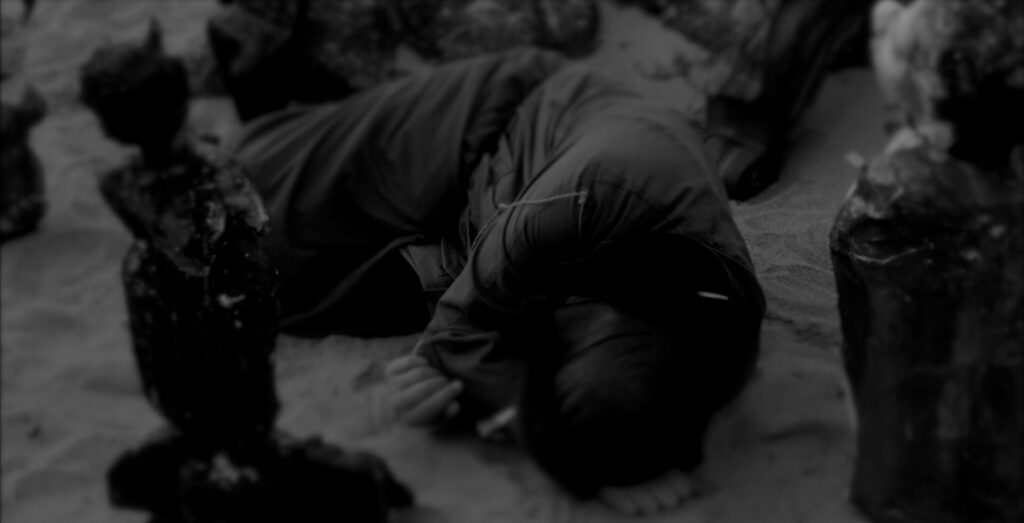
The island itself is a metaphor for the problems of digging deep into the layers of folk history. If you run the name Eilean a’ Bhàis into Google, of course you learn it doesn’t exist. The top link offered to you is the Wikipedia entry for Eilean-a-beithich, or the Island of the birches in the Hebrides which was originally 10,000 square metres but was eventually quarried to a depth of 76 metres below sea level, with just a thin rim holding the sea at bay. This collapsed suddenly and catastrophically during bad weather in 1881 leaving only the tips of the jagged circumference still visible above the waves to this day. A warning to the curious indeed.
The most recent iteration of Ravage is a live show which makes up part of the bill at Sensoria festival in Sheffield this month. She says: “The music will be performed solo on an old Scottish dulcitone and portable harmonium. The songs, written by Luce Moncrieff, comprise Gaelic laments, ballads and lullabies alongside her own, rather more strange, lighthouse compositions. She is the last surviving part of Kristján Norge’s personality and part of his system which attempts to reverse his self-awareness of his demonhood. For Norge, this diabolic knowledge was imparted to him by the Sluagh nam Marbh or Gaelic wind of voices. The dead revealed to him who he really was: only the image of a poet living on an island.”
So Norge’s realisation that he is a demon is perhaps only a sublimation of the more profoundly awful awareness than he is a literary character (to put yourself in his place perhaps think of the nagging jolt you may have received when first encountering simulation theory). No wonder he throws himself so energetically into his final bout of work. As well as the poetry, the drawings made with fire, the star charts, the occult writings scratched frenziedly into lighthouse walls, Norge made a number of ships figureheads and Ravage can be seen as the preparation for a highly unusual journey as much as an attempt to forget. These figureheads (along with Norge’s other icons of madness) actually exist in real life. Norrie, who puts most artists who write the term ‘multimedia’ in their CV to shame, explains: “I’ve been researching figureheads for some time, considering the ship as the floating shrine of a marine icon. I made and found the ten figureheads in the book, but scale was difficult because they would need to be transported to the sea for the film that was made and so I worked with the smaller scale figureheads traditionally used for fishing boats and light vessels.”
You’ve probably realised by this stage that it would be a fool’s errand to try and delimit the work of this artist who has clearly kept on pushing outwards since her time at the Ruskin School of Fine Art, Oxford instead of funnelling inwards into a role with lucrative commercial applications. Likewise as a poet, her focus, technique, subject matter and style shifts from project to project, making any summation like this feature redundant as anything other than an introductory sketch. For her, numerous unique modes of expression and a delight in intense periods of research are synthesized to become the most fearsome weapon in her armoury. This practice feeds a body of work – which includes not only everything mentioned so far but also Gaelic singing, historical non-fiction book writing, recording folk and rock music, collaborative filmmaking and performance art – that have variously included interviewing the great grandson of Sitting Bull and sleeping on fairy mounds all of which mixes with the idea of a succinct precis in the same way oil tends to mix with water.
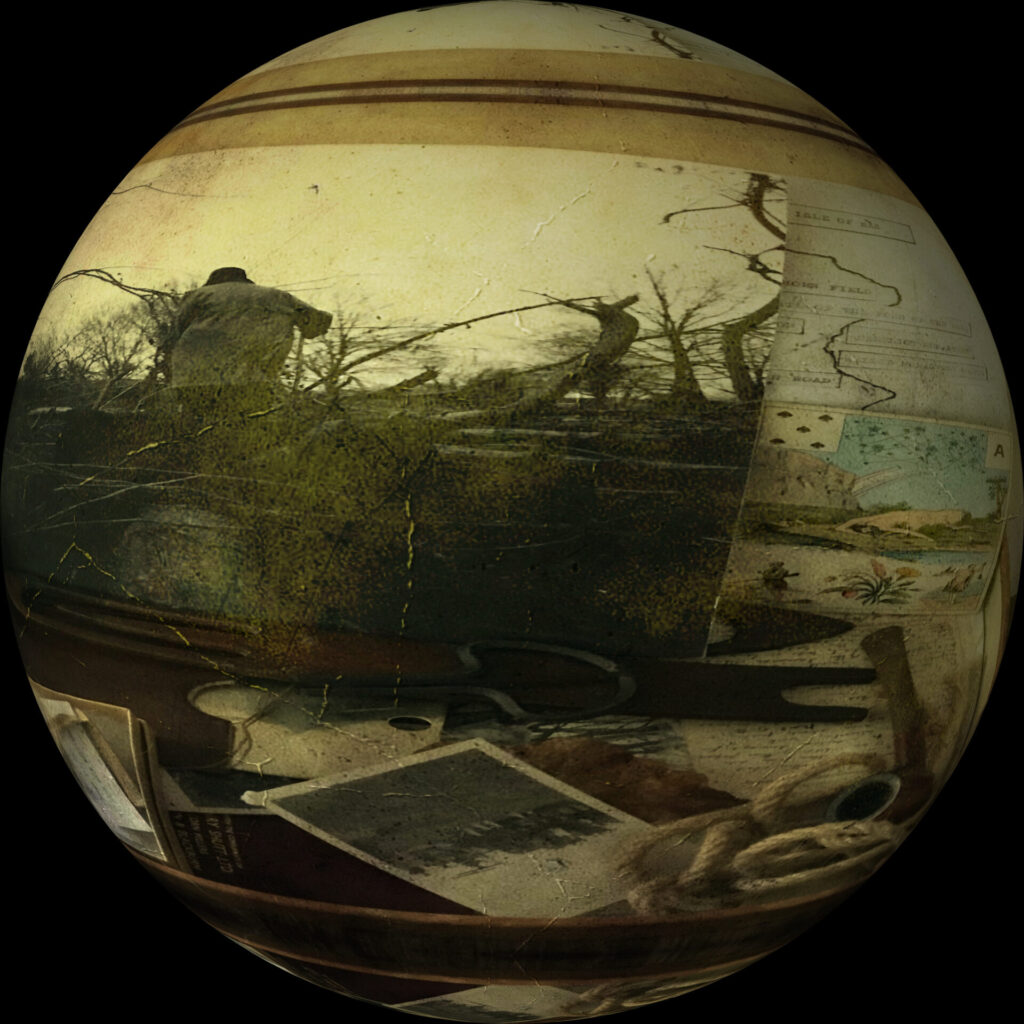
One aspect of this varied practice could be summed up in brute terms as the idea of looking back to look forward, or looking in to look out, arguably one of the things she is doing with Ravage and the story of Norge. Norrie has dedicated a big portion of her adult life to the exploration of Scots Gaelic culture – the tricksy and dangerous research which has fed back into her work in many different ways. Her obsession with this history and her (seemingly) unique interaction with it and perspective on it can perhaps be explained somewhat by her relative position which is simultaneously one of long-standing family heritage and notable outsiderism.
She describes her background as “mongrel” as she explains that a peripatetic Forces upbringing, which saw her move around a lot during her childhood led to her obsession. Her father and mother are Scottish as Scottish can be. It is her matrilineal heritage that has provided her with the stage and literary persona of MacGillivray under which she publishes and performs (her mother’s maiden name and her grandfather’s: Prof. Ian MacGillivray, who is buried in the MacGillivray graveyard at Dunlichity, Inverness).
She is a walking compendium of Scottish arcana, among many other things, and perhaps resembles one of the amateur obsessives of Scottish historiography she so admires, such as the reverend-scholar Robert Kirk who was said to have been finally absorbed into a fairy mound after a lifetime chasing and writing about the Sìdhichean. This, to me, is as useful a metaphor as you could wish for to illuminate what has happened to Norrie over the years in her pursuit of this subject. In fact, she tells me at the end of our interview, there is a third book of Norge’s writing due at some point in the next two years. Until The Twilight Fails is “based on a 1977 notebook discovered by Shetland Museums archivist Mark Ryan Smith, written by Norge, which seems to suggest the poet felt he had descended into the subterranean world of the Sìth and is written in what he termed ‘Sìthean Pentameter’”. In short, the mad poet Norge did not fall into Hell so much as he fell into a fairy mound.
She is quick to dissuade anyone seeking easy answers to her practice when pointing out that any number of other ulterior factors may have fed into her vision as regards her relationship to Scottish folklore history… not the least of which was the state of her own vision – or eyesight – itself. She explains: “The experience of being short-sighted and not knowing it led to me reading atmospheres and presences first and foremost.” She says that she wrote the manuscript within a book, Optik, in order to make sense of her own “sightings of the phantasmagoric with the poor visual awareness I had as a child”. When looking at her biography one can find oneself reaching out to grab hold of what initially looks like a piece of concrete evidence just to find one has grasped firmly onto a spunkie instead.
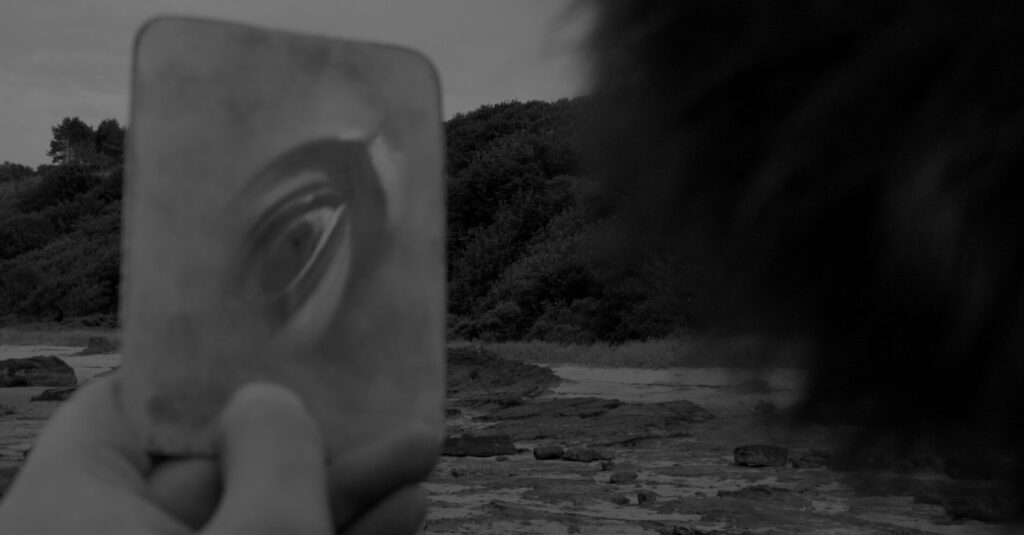
It is not unheard of for British contemporary and progressive artists to have a deep investment in the types of traditional cultures, practices and languages once marginalised after the industrial revolution but it is still uncommon enough for this practice to then be re-presented in a 21st century context outside of the static enclosure of pure heritage and preservation.
In the field of pop music Gwenno followed up her 2014 Welsh language album Y Dydd Olaf with Le Kov which was sung entirely in Cornish. And in the field of folk music, Laura Cannell – who specialises in playing ‘double-headed recorders’ and the under-bowed violin – combines ‘early music’ with improvisation to produce ancient sounding but utterly modern instant compositions. Kirsten has performed with Laura twice to date. Richard Dawson, another artist who has utilised long periods of research, recorded the album Peasant which was ostensibly set in Bryneich, the ancient Welsh name for the kingdom that existed in Yr Hen Ogledd – The Old North – in the area that became the kingdom of Northumbria and the Scottish Borders in the seventh century. Norrie travels deeper still however and her reasons for doing so are less easy to pin down. It is the extent of her immersion that is really remarkable as it appears – to an outside observer at least – that the distinctions between art and quotidian life have become blurred, that if there once was a boundary separating them, it has become porous if not dissolved altogether.
While this immersion is undeniable, she rejects any explicit political commentary and only acknowledges the idea of looking back to look forward cautiously: “When I spoke to him, Ernie LaPointe, the great-grandson of Sitting Bull, had something of deep significance to say on this matter which is that we must be ‘humble and pitiful and look to the future, not the past.’ I said, ‘Ernie, do you really mean pitiful?’ He said, ‘Yes, I do.’ I said ‘Why?’ and he responded, ‘Because to look into the future is to be pitiful.’” Her interest in native American culture is ongoing and a non-fiction work Eagle Song: A Spirit Road Trip is published by Unbound in 2026, drawing striking parallels between Native American tribal and Highland clan cultures, catalysed by her trip to record Ernie at his home near Deadwood.
She adds: “I don’t operate from the perspective of a political agenda illustrated by poetry or music, or by an underlying political viewpoint. I simply make work that will only cease when I work out a certain call or obsession to create its existence.”
When I tentatively suggest the idea that what she does constitutes a form of magic postmodernism she won’t bite, but does add: “I try to produce an alchemical schema, but a short-changed kind of alchemy; something which is foolish, or flawed, but with intimations of the holy either as an endeavour or as a result.”
The kaleidoscope keeps on appearing in her work – she has used it as a substitute hallucinogen in the past in the same way she has stood under the jet of a waterfall until visions occur – and Norrie acknowledges that, for her at least, it is a black mirror: “In my book The Nine Of Diamonds the kaleidoscope is an unruly lens, a psychedelic scrying device – psychedelic in the way that, to my mind, the Pre-Raphaelites used Technicolor ahead of its cinematic invention. In Ravage, Norge relates it to early optics and what he calls sleight-of-eye: it’s a rough link between these books.”
But MacGillivray employs a kaleidoscopic and ever shifting pattern of techniques that cleave and shatter pleasingly before reassembling phantasmagorically and colourfully with each project. It feels as if there are more historical subjects and more potential techniques for vividly capturing these folk essences and more potential futures to augur than there are Munros for the bagging in the Highlands; and that Kirsten Norrie herself is only just warming up to the task in hand.
MACGILLIVRAY and Burd Ellen play Sensoria Festival on Saturday 5 October. Kirsten Norrie’s new novel published later this year An American Book of the Dead: A Wild West Séance, is an Acid Western “whose psychedelia stems not from drugs but from the spirit world”

